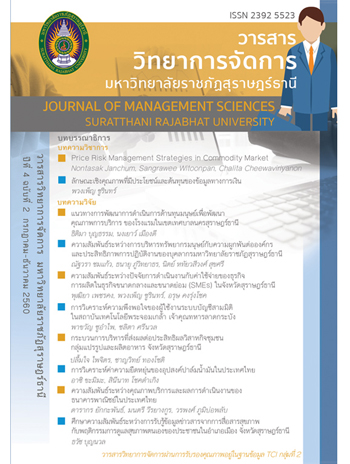การวิเคราะห์ค่าความยืดหยุ่นของอุปสงค์ปาล์มน้ำมันในประเทศไทย
Main Article Content
บทคัดย่อ
งานวิจัยเรื่อง การวิเคราะห์ความยืดหยุ่นของอุปสงค์ปาล์มน้ำมันในประเทศไทยมีวัตถุประสงค์เพื่อวิเคราะห์ความยืดหยุ่นของอุปสงค์ปาล์มน้ำมันในประเทศไทย ใช้ข้อมูลอนุกรมเวลารายเดือน ตั้งแต่เดือนมกราคม ปี พ.ศ. 2557 - ธันวาคม ปี พ.ศ. 2559 ตัวแปรที่ศึกษา คือ ราคาปาล์มน้ำมันและราคาถั่วเหลืองในประเทศไทย ปริมาณการใช้ปาล์มน้ำมันและปริมาณผลิตภัณฑ์น้ำมันปาล์มในประเทศไทย พบว่า ความยืดหยุ่นของอุปสงค์ของปาล์มน้ำมันในประเทศไทยต่อราคาปาล์มน้ำมันมีค่า -0.52 คือ อัตราการเติบโตของราคาปาล์มน้ำมันเปลี่ยนแปลง 1% ทำให้อัตราการเติบโตของอุปสงค์ปาล์มน้ำมันในประเทศไทยเปลี่ยนแปลงในทิศทางตรงกันข้าม 0.52% ความยืดหยุ่นของอุปสงค์ปาล์มน้ำมันในประเทศไทยต่อปริมาณผลิตภัณฑ์น้ำมันปาล์มในประเทศไทย มีค่า 0.28 คือ อัตราการเติบโตของปริมาณผลิตภัณฑ์น้ำมันปาล์มในประเทศไทยเปลี่ยนแปลง 1% ทำให้อัตราการเติบโตของอุปสงค์ของปาล์มน้ำมันในประเทศไทยเปลี่ยนแปลงในทิศทางเดียวกัน 0.28% ความยืดหยุ่นของอุปสงค์ปาล์มน้ำมันในประเทศไทยในปีปัจจุบันต่ออุปสงค์ปาล์มน้ำมันในประเทศไทยในปีที่แล้ว มีค่า 0.35 คือ อัตราการเติบโตของอุปสงค์ปาล์มน้ำมันในประเทศไทยปีที่แล้วเปลี่ยนแปลง 1% ทำให้อัตราการเติบโตของอุปสงค์ปาล์มน้ำมันในประเทศไทยในปัจจุบันเปลี่ยนแปลงในทิศทางเดียวกัน 0.35%


